
EDIBLE LEAVES IN PAPUA NEW GUINEA II
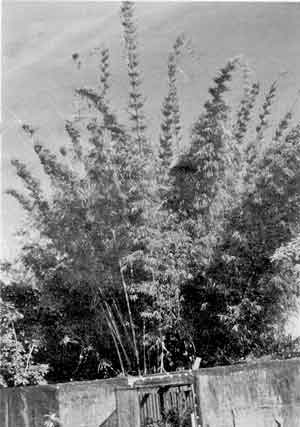 | GRAMINEAE (POACEAE): Grasses Roots fibrous, stems herbaceous or woody and arborescent (bamboos), usually hollow; leaves alternate, arising from solid nodes in the stem, leaf base stem-sheathing. The basic inflorescence unit is a spikelet, the flowers subtended by chaff-like glumes. The most widespread plant family. BAMBUSA FORBESII (Ridl.) Holttum |
| Nastus elatus |
NASTUS ELATUS Holttum Nastus elatus is endemic to New Guinea, wild in forest, and cultivated from altitudes of 600 to 2000m; propagated by clump division. The culms are used for construction, flattened to weave house walls and floors, cut up for water buckets (lengths 2m long with all but the lowest septum broken out), cooking pots (single internode plus septum) or split to make arrow-points, tongs, knives and other utensils. Many cultivars are known and named by village people, suited to various uses, and some of them yield high-quality shoots for eating. The species is not known wild outside New Guinea, but sometimes cultivated; in southern Bougainville, in 1974, a man had a plantation on a mountain above his village, of a wide-diameter, thin-walled cultivar, in demand for weaving walls, from which he sold culms for 20 toea each. | 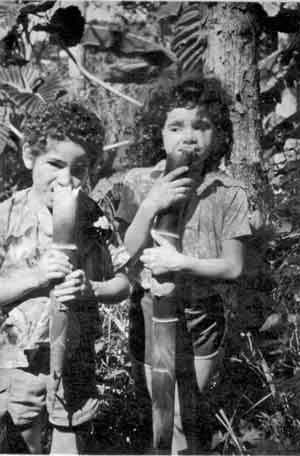 |
| Nastus elatus shoots, edible even uncooked |
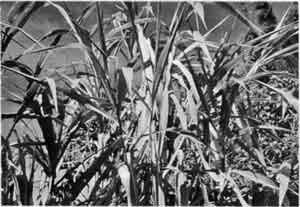 | SACCHARUM EDULE Hassk. Pit-Pit (P) The part eaten is not the leaf, but the abortive inflorescence; this is, however, an important vegetable and does not fit into any other category, either. The inflorescence develops, within its sheathing bracts, to a body 10-15cm x 2-3cm, cream or pinkish in colour, with a firm, somewhat crumbly texture. It never emerges, and rapidly deteriorates if not gathered when ready. The head, with the bracts in place, may be roasted over a fire (or in an oven), or the 'flowers' removed and boiled with other foods, or cooked in a mumu with coconut milk, which enhances the delicate flavour. Pit-Pit is cultivated throughout New Guinea, from low altitudes to at least 1500m. Propagation is by cuttings, as with sugar cane. Many named varieties exist, including early, mid-season and late-maturing forms. It is a favoured vegetable and large quantities are sold in markets. |
| Saccharum edule (Pit-pit) |
SACCHARUM OFFICINARUM L. Sugar Cane (E) Suga (P) SETARIA PALMIFOLIA (Willd.)Stapf. Highland pit-pit (E) The main zone of cultivation is from altitudes of 1000 - 2000m, but the grass grows quite well at low altitudes if the rainfall is good and it is given partial shade. The wild form is found throughout the old-world tropics; the cultivated form is known from tropical Asia to the Pacific; propagated by side-branches. For eating, the stem tips are split and the tender developing leaves extracted for cooking. Bundles of the tips, 15- 20cm long, may be seen for sale in markets. | 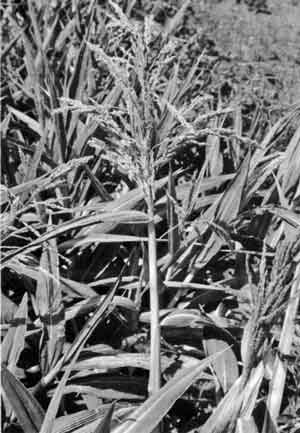 |
| Setaria palmifolia |
Fam. LEGUMINOSAE sub-f. Papilionoideae (FABACEAE): Trees, shrubs, herbs, many vines, sometimes with tendrils: leaves alternate. mostly compound. Flowers with 5 petals, the 2 lower usually joined to form a keel, overlapped by the lateral pair (wings), these overlapped by the single, usually largest, upper petal (standard). Stamens usually 10, all free, or joined in 2 groups. Fruit a pod, dehiscent or not.
A large diverse, group:
garden ornamentals, Clianthus (Desert pea), Lathyrus (Sweet pea), Lupinus (Lupin);
trees, Castanospermum (Black Bean), Erythrina (Coral tree);
food plants, peas and beans, peanuts;
pasture and fodder plants, Centrosema, Medicago (lucerne), Pueraria, Stylosanthes (Townsville lucerne), Vigna (Cowpea) and so on.
PSOPHOCARPUS TETRAGONOLOBUS L.DC.Winged Bean (E)
Herbaceous vine, without tendrils; roots tuberous (under optimum conditions); leaves trifoliate, leaflets from 5 x 4cm to much larger. Flowers in small clusters on stalks about 10cm long; standard 3 - 4cm across, usually blue or purplish, sometimes cream or greenish cream, even red. Pods 8 - 30cm long, with wings 5 - 10mm wide along the 4 angles; seeds 5 - 20, globose, 6 - 10mm across, brown or black when mature.
The origin of this plant is uncertain; now it is cultivated from West Africa to Southern Asia, through Malesia to the Pacific; in New Guinea from sea level to 2000m or more, with many named varieties; propagated by seed. The optimum altitude seems to be from 1000 to 1500m; at low altitudes, tubers are not formed.
The young leaves, open flowers, immature pods and almost-mature seeds are eaten; all these are high in protein. In Papua New Guinea, the tubers are the important part of the crop; high in protein, with an attractive flavour, they are a favoured food. The plant is grown as a delicacy rather than as a staple; it is more demanding of soil and climate, and more labour-intensive, than the standard food crops. Fairly large patches are sometimes seen in cultivation, probably intended for special occasions.
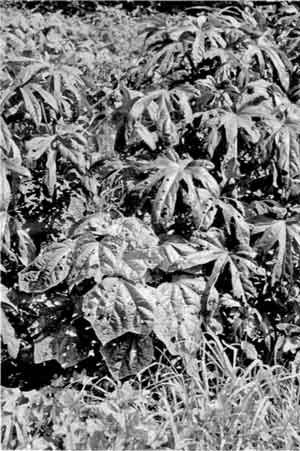 | Fam. MALVACEAE: Herbs, shrubs or trees, bark often fibrous; leaves alternate. Calyx various, with sometimes a second below; petals 5, often large and coloured; stamens many, forming a column. Fruit a dry capsule. Various kinds of Hibiscus are popular ornamentals, cotton (Gossypium) is a commercial crop, and Sida species are well-known as weeds. ABELMOSCHUS MANIHOT L. Medicus .. Aibika (P) Aibika is cultivated from India to Southeast Asia, through Malesia to the Pacific; in New Guinea from low altitudes to 2000m. Propagation is usually by cuttings, but viable seed is produced, hence the multiplicity of forms. When cooked, the leaves have a pleasant flavour, but are rather mucilaginous. They are probably the most favoured leaf vegetable in Papua New Guinea, grown throughout the country in a wide range of habitats; not always found in markets, but the reason for this could be that the producers are not growing enough for themselves. The plants may be heavily damaged by insects, particularly, it seems, the more desirable cultivars. |
| Hibiscus manihot |
Fam. MORACEAE: Trees or vines, sap often milky, leaves mostly alternate, sometimes opposite. Flowers small, male or female, in separate inflorescences or together. The family includes various fruit trees: Artocarpus, breadfruit and jackfruit, Ficus, fig and Morus, mulberry.
FICUS, Fig (E) Pikos (P) Flowers on a receptacle which is turned inwards into a more or less globose shape, the flowers on the inside, with a small opening at the apex. Pollination is dependent on small wasps, which are specific, so that a species of fig, taken to a locality where its wasps do not occur, will not set seed. A large and variable genus, including shrubs, small to large trees, vines and the well-known stranglers.
FICUS COPIOSA Steud. This species is widespread in Papua New Guinea, from low altitudes to about 2000m, also in western Malesia. It is often cultivated about villages, propagated by cuttings. The young leaves, picked from village plants or wild trees in the bush, are a popular green, and the fruit is also edible, to various degrees. There are cultivars with soft, sweet fruit. FICUS DAMMAROPSIS Corner. The species is endemic to New Guinea, and cultivated throughout the central highlands of Papua New Guinea, from 800 to over 2000m. No doubt there are wild trees, but they all seem to be claimed by somebody. Propagation is by cuttings or seed. The young leaves, collected as they burst from the bud, when 10-12cm long, are used as a vegetable. FICUS WASSA Roxb. Native to New Guinea, rather common in forest at low altitudes, often cultivated about villages. The young leaves are picked and cooked as a vegetable. | 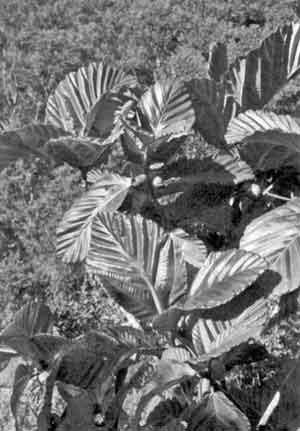 |
| Ficus dammaropsis |
Fam. PALMAE (ARECACEAE): Palms. Roots fibrous; trunk erect, usually unbranched, with leaves arising at the top from a single terminal bud. Leaf-bases sheathing the trunk, forming a crown shaft (Archontophoenix, Bangalow palm), then the leaves fall as the flowers emerge, so that the inflorescences are below the leaves; or leaf bases not sheathing, with the inflorescences and fruit among the leaves (coconut); or the palm monocarpic, with a single flowering phase (see below).
CARYOTA RUMPHIANA Mart. Fishtail palm (E) Limbum (P)
Robust, tall palm, fronds bipinnate, the pinnules triangular. Inflorescence a dense cluster of hanging stems, to 1 m long. Fruit succulent when ripe, dark red to black, 10 - 15cm diameter, with 1 or 2 seeds. Monocarpic; when mature, the palm flowers near the top, then progressively down the trunk, and finally dies.
This is the 'toddy palm' of tropical Asia; widespread at low altitudes in Papua New Guinea, but not cultivated except as an ornamental in gardens and parks. The 'palm cabbage' (see coconut) is edible, but this palm is more valued by village people for the production of bows, if 'black palm' (Ptychosperma and other genera) is not available. The ripe fruit of Caryota contains raphides (needle-like crystals of calcium oxalate), which are very irritating to the skin, so seed should be collected with caution. The same caveat applies to Arenga which is also monocarpic, and to the Australian Carpentaria which is not.
The Pidgin name 'limbum' applies to any palm, excepting those more specifically named (kokonas q.v.; buai, betel nut; sak-sak, sago; kanda, Calamus) and particularly to those used to produce planks for the floors of houses.
COCOS NUCIFERA L. Coconut (E) Kokonas (P)
No description seems necessary. The developing bud ('palm cabbage') is a valued food, but since there is only one bud and its removal results in the death of the palm, it is rarely available. When it is, it may be boiled or steamed, or used to add its pleasant nutty flavour to a mumu, or cut up and eaten raw as salad.
Fam. PORTULACACEAE: Herbs; leaves alternate or opposite, usually fleshy. Flowers regular, sepals 2, petals 4 or 5; fruit a capsule, usually many-seeded. The most familiar genus is Portulaca; species are known as ornamentals, weeds, and inconspicuous under-herbs in grassland.
PORTULACA OLERACEA L. Pigweed (E)
Low herb, sometimes to 20cm tall; leaves opposite (mostly), fleshy, shining. Flowers yellow, from the leaf-axils, 5 - 10cm across. Seeds many, small, black, granular.
A pan-tropical weed, also well-known in temperate regions; apart from the numerous seeds, pieces of stem, broken by cultivation, readily produce roots and grow again. Widespread in New Guinea and found in gardens at most altitudes. Although it is never planted, the leaves are used when available, usually added to other leaves for cooking.
Fam. SOLANACEAE: Herbs, shrubs or sometimes small trees; leaves alternate. Flowers regular, calyx and corolla usually 5-lobed. Fruit a berry or capsule. An important family economically, most developed in South America, where potato (Solanum), tomato (Lycopersicon), tamarillo (Cyphomandra) and Capsicum originated; ornamentals are Browallea, Cestrum and Petunia; many species contain poisonous substances, particularly in Brugmansia, Datura, Nicotiana (tobacco) and Solanum, a very large genus).
SOLANUM AMERICANUM Mill. Black Nightshade (E)
Perennial branching herb, 30 - 100cm tall; leaves alternate, very variable in size. Flowers in small clusters between the leaves; corolla white, 5 - 10mm across. Berry globose, to 10mm across, dark purple to black when ripe.
Though first named from American material (in 1768) this species is pantropic and probably long precedes European exploration. It is found throughout New Guinea, cultivated and wild, from low altitudes to at least 3000m. The stem tips are a popular green, and bundles are often on sale at markets. This use also extends to the Pacific and to Indonesia. Despite its somewhat sinister common name, poisonous properties have not been demonstrated.
Fam. UMBELLIFERAE (APIACEAE): Mostly herbs, often more or less aromatic; leaves mostly alternate, the base to some extent stem-sheathing. Inflorescence umbellate (see ARALIACEAE). Flowers regular, petals 5, ovary inferior. Fruit breaking into 2 dry, 1-seeded carpels. Carrot (Daucus), parsnip (Pastinaca), parsley (Petroselinum) and celery (Apium) are well-known cultivated plants.
Hemlock (Conium) is a traditional poison (used to execute Socrates).
CENTELLA ASIATICA L. Urb.
Low creeping plant, stems slender, rooting at the nodes; leaves entire, almost circular, 1 - 4cm across. Flowers in small, short-stalked umbellate clusters from the leaf-axils, greenish.
The plant occurs naturally from India to China, through Malesia to the Pacific, and in Australia; in New Guinea, from low altitudes to at least 1500m, particularly in gardens, short pastures and lawns. Probably it is never cultivated, but the leaves are sometimes gathered for cooking, and also used medicinally.
OENANTHE JAVANICA (Bl.) DC.
Herb, stem green with small purplish flecks, prostrate or ascending; leaves 4 - 8 x 3 - 5cm divided to the veins into toothed leaflets. Flowers whitish, in compound umbels on rather long stalks opposite the leaves.
Wild and cultivated throughout New Guinea, from about 400 to 2000m altitude, preferring wet soil beside ponds and small creeks, often under partial shade, particularly at the lower altitudes; propagated by stem-cuttings. The plant is also well-known in Indonesia. It is a very popular green within its range, eaten either raw or cooked. It is persistent, once established, and may be planted about temporary shelters used by people in transit, or hunting parties, for future use. Hunters who expect to spend several days in the bush have been known to express a preference for the wild form over the domesticated plant; it is presumably less digestible and a feeling of emptiness takes longer to develop.
DATE: May 1988
* * * * * * * * * * * * *
